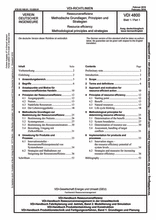Standards Worldwide
Standards Worldwide
Phone +49 30 58885700-07

Technical rule [CURRENT]
VDI 4800 Blatt 1:2016-02
Resource efficiency - Methodological principles and strategies
- German title
- Ressourceneffizienz - Methodische Grundlagen, Prinzipien und Strategien
- Publication date
- 2016-02
- Original language
- German, English
- Pages
- 54
- Publication date
- 2016-02
- Original language
- German, English
- Pages
- 54
Product information on this site:
Quick delivery via download or delivery service
Buy securely with a credit card or pay upon receipt of invoice
All transactions are encrypted
Short description
Using this standard for increasing resource efficiency can make a contribution to the conservation of natural resources, including, but not limited to the use of raw materials and water, the use of land, the reduction of environmental pollution and thus to preserve the living conditions for present and future generations. For this, the Standard presents approaches and assistance for the analysis and assessment of technical and socio-economic systems. These serve to develop and evaluate strategies for resource efficiency. In many cases, conservation of natural resources is in line with economic targets such as the good management of an Operation's input factors. In these cases, an economic analysis will also increase resource efficiency in the sense of this standard. The standard provides a methodology for evaluating resource efficiency of products, services, product service systems and organisation. Resource efficiency is defined as the ratio of a quantifiable benefit and the associated natural resource amount. The resource amount can be quantified and evaluated by a number of indicators (cumulative raw material demand, cumulative energy demand, water and land and ecosystem services use, including environmental sinks). The result is highly dependent on methodological decisions and rules (e.g. choice of system boundaries, allocation rules). The standard gives assistance and recommendations for this. The standard emphasises that optimising resource use is possible at all stages of a product life cycle chain and in the production system (raw material extraction, production and manufacturing, use and end of life phase). Furthermore, the standard describes strategies and measures to increase resource efficiency and to enable industry and service providers to identify potentials for improvements.
Content
ICS
03.100.01,
13.020.01
Also available in
Loading recommended items...
Loading recommended items...
Loading recommended items...
Loading recommended items...
